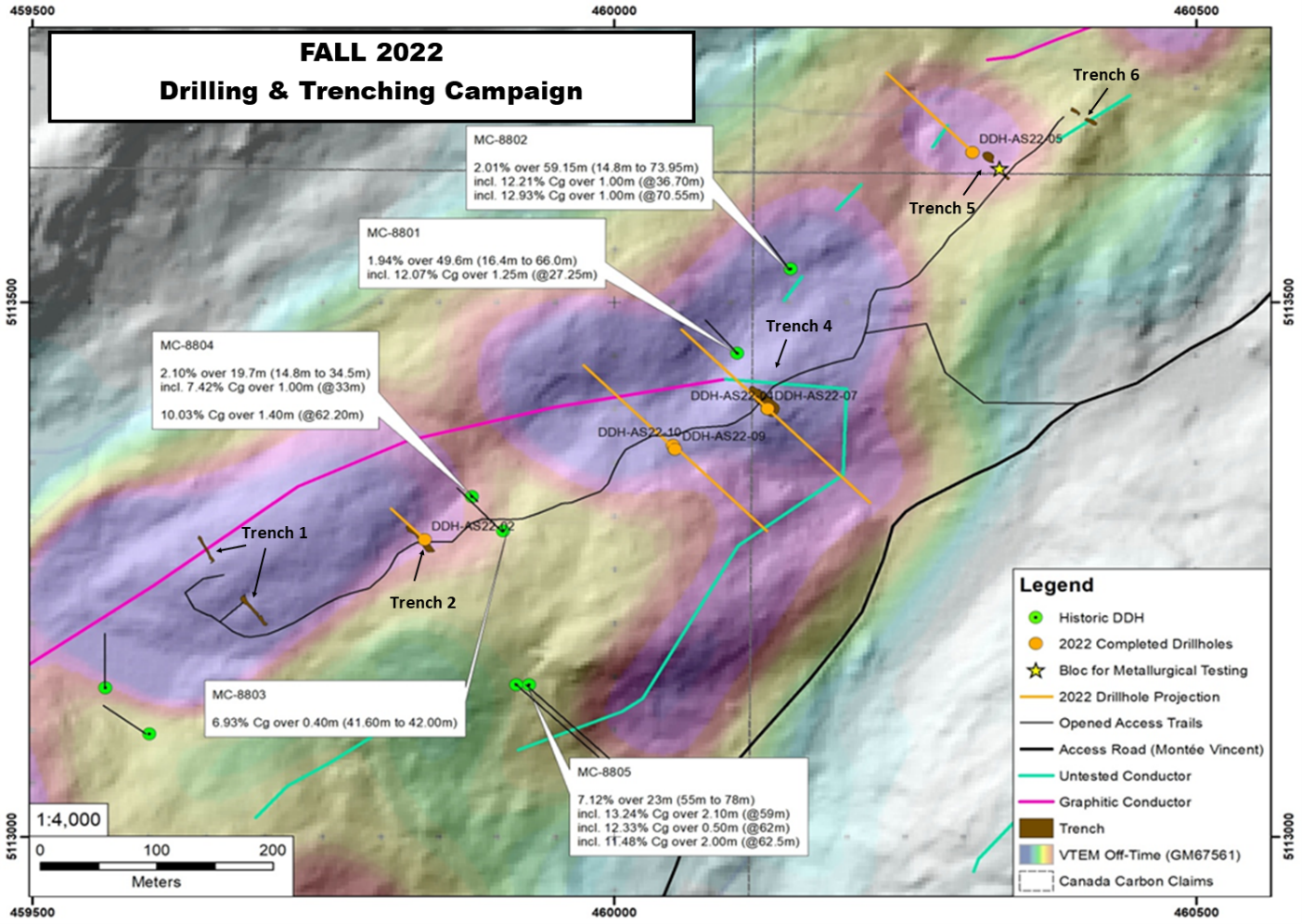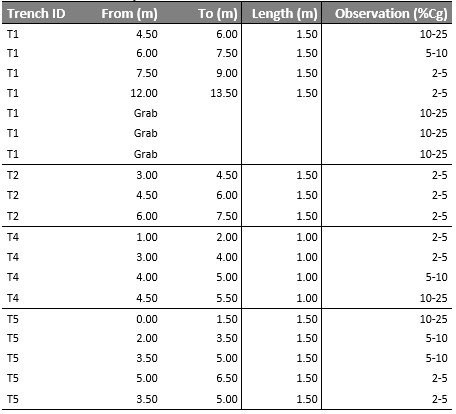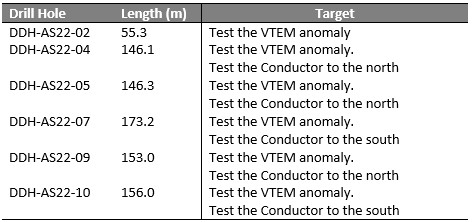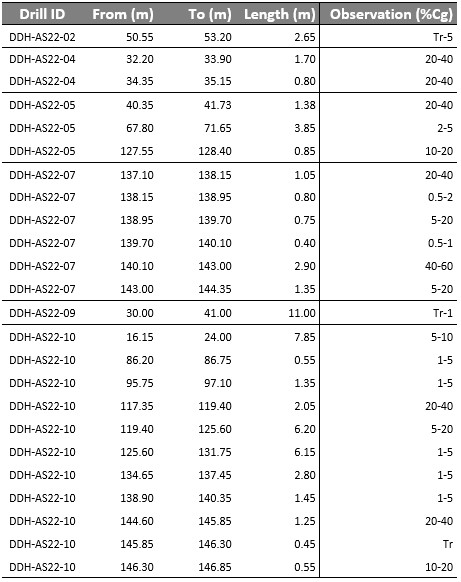Press Releases
Canada Carbon Announces Completion of Drilling Program on Its Asbury Property (English) |
January 9th, 2023, Toronto, Ontario, Canada - Canada Carbon Inc. (the "Company" or "Canada Carbon" or "CCB") (TSX-V:CCB),(FF:U7N1) is pleased to announce that it has completed its trenching and drilling campaign near the MC-8805 showing on the eastern part of the Asbury Property. The Program Prospecting in 2021 returned mineralized grab samples (21.50 %, 5.85% and 18.80% Cg) in the NE part of the Property, near the MC-8805 showing. Historic drill holes (St-Pierre, 1988) in the vicinity of the showing returned 8.14% Cg over 18.9 meters. This area was the main target for the Fall 2022 exploration campaign which consisted of 60.5m of trenching in 5 trenches and 830m of drilling in 6 diamond drill holes (“DDH"). In addition to drawing on extensive historical information, the trenching and drill survey used VTEM anomalies and EM conductors (Dubé, 2013) along with recently observed mineralization discovered during the latest surface exploration phase to find the local targets. Figure 1 show the location of the program along with some of the most prominent geological features of the area. Figure 1: Historic Drill Holes plus Planned Trenches and Drill Holes in Fall 2022 Campaign
Observations of the core and channel samples indicate that the host rocks are skarns, massive quartzites and banded porphyroblastic paragneisses. Graphite is present in all three lithologies, either as disseminated, veins or massive intersections. Sulphides (pyrite, pyrrhotite and sometime galena) are present as traces, clusters, stringers or chunks. Common alterations are carbonatization, ankeritization, chloritization or silicification. Trenching In trenches, the main graphite corridor (>10% visual graphite) thicknesses ranges from 0.8m to 2.9m apparent thickness, the mineralization is hosted in metric sized lower grade graphite layers (>1% but <5% graphite). All of the graphite intersections (from trace to >10% visual graphite) appear to range in thicknesses from 0.4m to 11m with an average of 2.42m. Laboratory results will better indicate the extent of the high grade and lower grade mineralization. Table 1 shows the trench length and targets while table 2 shows the principal observations in the trenches. A total of 63 channel samples have been sent to Actlabs laboratory in Ancaster (Ontario) for graphite package analysis (RX1 preparation and C-Graphitic analytical package).
Table 1: Trench Details
Table 2: Channel Samples Observations
Photo 1
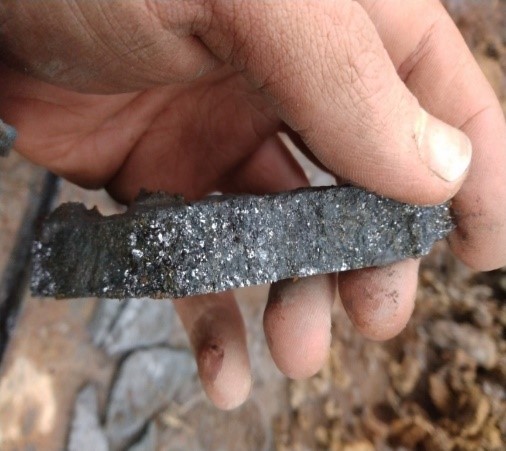 T1: 4.5-6m, visual estimates of 10-25% graphite Photo 2
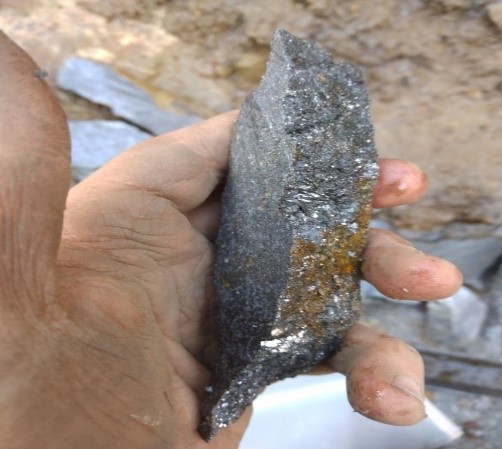 T1: 4.5-6m, visual estimates of 10-25% graphite Photo 3
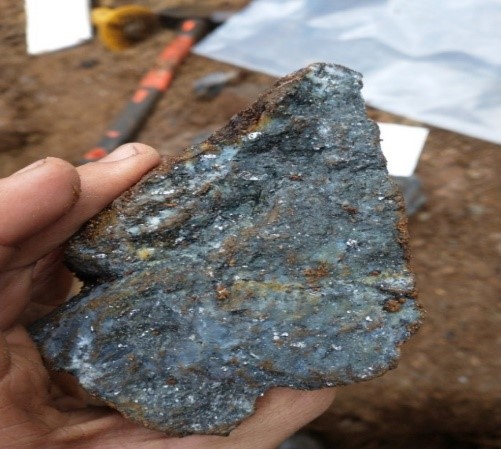 T1: 4.5-6m, visual estimates of 10-25% graphite
Photo 4 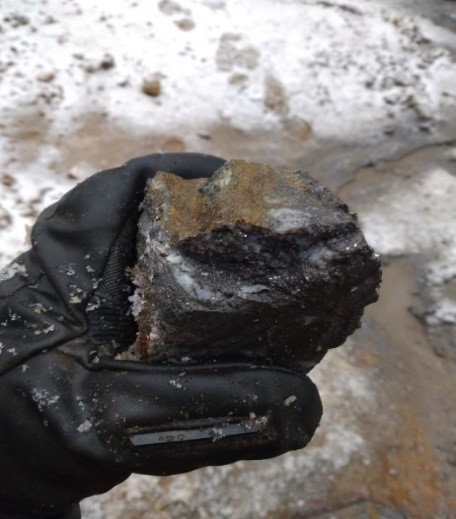 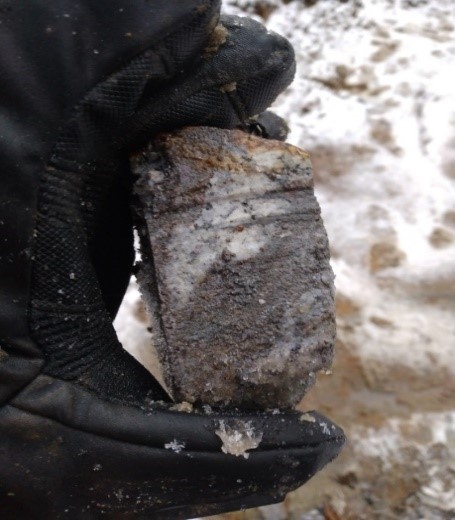 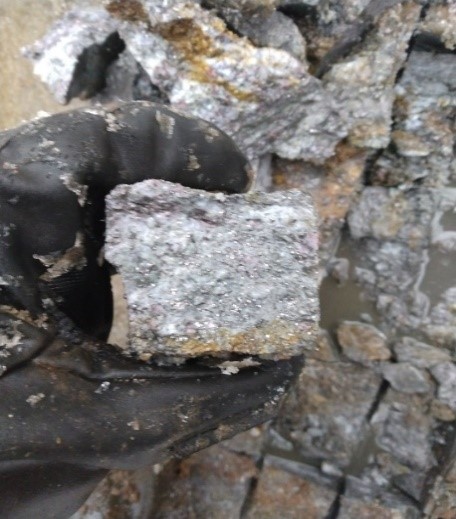 T1 grab samples: visual estimates of 10-25% graphite
Table 3 shows the length of the drillholes and target areas, while table 4 shows the preliminary information obtained during logging. The length of the holes was planned to mostly target shallow EM and VTEM anomalies (within 100m vertical depth). Where access was temporarily impossible (e.g. planned holes DDH-AS22-02 and DDH-AS22-07), the drill pads were moved further away from the target and increased in length to test the depth of the anomalies. All the holes have a NQ diameter. A total of 504 samples were collected following the drilling and have been sent to Actlabs laboratory in Ancaster (Ontario), including standard samples for graphite package analysis (RX1 preparation and C-Graphitic analytical package). Pyrite, pyrrhotite and magnetite have been observed in drill cores and could be responsible for some of the VTEM anomalies, but the VTEM anomalies cannot be solely explained by these minerals, as the high concentration of these minerals are associated with high concentrations of graphite (see drilling mineralization highlights). Intersections not associated with graphite have very low concentrations of pyrite and pyrrhotite. In DDH-AS22-02, a mineralized horizon was observed and sampled between 50.55m to 53.20m with visible graphite content ranging from trace to 5% in a fault gouge. We believe that this DDH didn’t reach the expected target and will be resampled in future drill programs. In DDH-AS22-04 a mineralized horizon was observed and sampled between 32.20m to 35.15m with visible graphite content ranging from 10% to 25% in a massive band. In DDH-AS-05, two main mineralized horizons were observed and sampled. The first mineralized horizon, between 40.35m to 41.73m has visible graphite content ranging from 20% to 40%. The second mineralized horizon, from 127.55m to 128.40m, has visible graphite up to 10%, and locally up to 20% in a fault from 127.90m to 128.10m. In DDH-AS22-07, a mineralized horizon was observed and sampled between 137.10m to 144.35m with visible graphite content ranging from 10% to 25% in a massive band and disseminated. In DDH-AS22-09, a mineralized horizon was identified and sampled between 30.00m to 41.00m with visible graphite, pyrrhotite and pyrite content locally ranging from trace to 1%. We believe this DDH didn’t reach the expected target and will be resampled in future drill programs. In DDH-AS22-10, three mineralized horizons were identified and sampled. The first mineralized horizon is between 16.15m to 24.00m, with visible graphite content of 2% and up to 10% in fault gouge. The second mineralized horizon is between 86.20m-97.10m with visible graphite content up to 5%, disseminated. The third mineralized horizon is between 117.35m-146.80m with visible graphite content of 5 to 25%. Photo 5
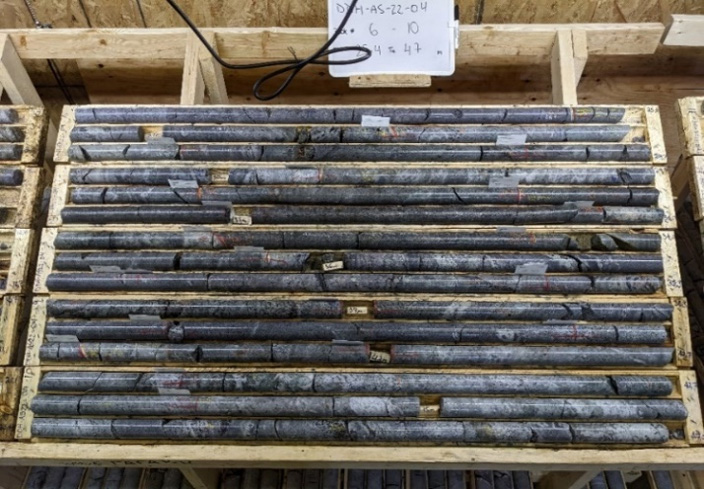 Hole DDH-AS22-04 from 25.4m to 47m Photo 6
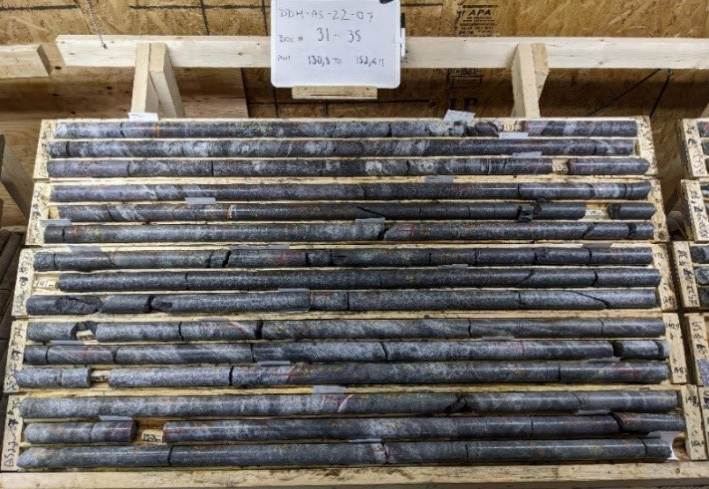 Hole DDH AS22-07 from 130.8m to 152.6m
Photo 7
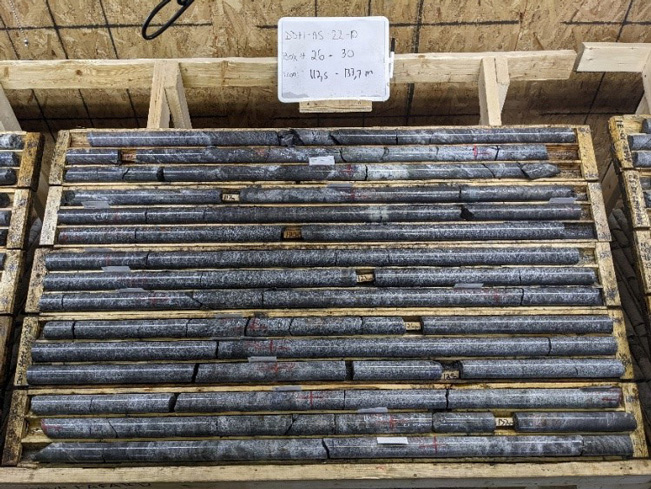 Hole DDH-AS22-10 from 112.5m to 133.7m Photo 8
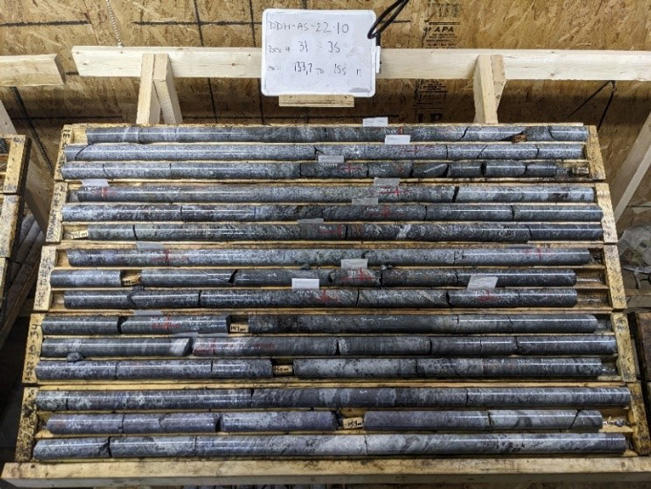 Hole DDH-AS22-10 from 133.7m to 155m
Table 3: Drillholes Details
Table 4: Drill Core Observations
Chief Executive Officer, Ellerton Castor, said: "These results underline our reasons for tremendous excitement about the future commercial potential of the Asbury property. We are working on a significant conductor that connects the currently investigated area to the historical Asbury mine, where commercial graphite production was achieved in the past. The current program was located approximately 4.5km from the Asbury mine and the conductor anomaly serves to connect the two areas. The Company believes that this corridor contains extensive mineralization and could generate significant resource potential as we have already demonstrated from the observations in the drilling and trenching recently completed." Qualified Person This press release was prepared by Steven Lauzier, P.Geo, OGQ; and by Pierre-Alexandre Pelletier, P.Geo OGQ, who are qualified persons as defined under National Instrument 43-101, and who reviewed and approved the geological information provided in this news release.
References Dube, J., 2013. Heliborne Magnetic and TDEM Survey, Island and Asbury Properties. Prospectaire Geosurveys Inc for Focus Graphite Inc. GM 67561. St-Pierre, S., 1988. Journeaux de Sondage, Campagne d'Automne 1988, Projet McGill. Stratmin Inc. GM 48577.
“Ellerton Castor” Chief Executive Officer and Director Contact Information E-mail inquiries: info@canadacarbon.com P: (905) 407-1212
FORWARD LOOKING INFORMATION This press release contains statements that constitute “forward-looking information” (“forward-looking information”) within the meaning of the applicable Canadian securities legislation. All statements, other than statements of historical fact, are forward-looking information and are based on expectations, estimates and projections as at the date of this press release. Any statement that discusses predictions, expectations, beliefs, plans, projections, objectives, assumptions, future events or performance (often but not always using phrases such as “expects”, or “does not expect”, “is expected”, “anticipates” or “does not anticipate”, “plans”, “budget”, “scheduled”, “forecasts”, “estimates”, “believes” or “intends” or variations of such words and phrases or stating that certain actions, events or results “may” or “could”, “would”, “might” or “will” be taken to occur or be achieved) are not statements of historical fact and may be forward-looking information. Forward-looking information in this press release includes statements regarding the development of the Company’s Miller deposit and financing thereof, the entering of the joint venture with Irondequoit Offering, future production from the Company’s Miller deposit, sales agreements and other matters related thereto. In disclosing the forward-looking information contained in this press release, the Company has made certain assumptions. Although the Company believes that the expectations reflected in such forward-looking information are reasonable, it can give no assurance that the expectations of any forward-looking information will prove to be correct. Known and unknown risks, uncertainties, and other factors which may cause the actual results and future events to differ materially from those expressed or implied by such forward-looking information. Such factors include but are not limited to: compliance with extensive government regulations; financial abilities; the ability to develop the Miller deposit; domestic and foreign laws and regulations adversely affecting the Company’s business and results of operations; the impact of COVID-19; and general business, economic, competitive, political, and social uncertainties. Accordingly, readers should not place undue reliance on the forward-looking information contained in this press release. Except as required by law, the Company disclaims any intention and assumes no obligation to update or revise any forward-looking information to reflect actual results, whether as a result of new information, future events, changes in assumptions, changes in factors affecting such forward-looking information or otherwise. Neither TSX Venture Exchange nor its Regulation Services Provider (as that term is defined in the policies of the TSX Venture Exchange) accepts responsibility for the adequacy or accuracy of this release. |

